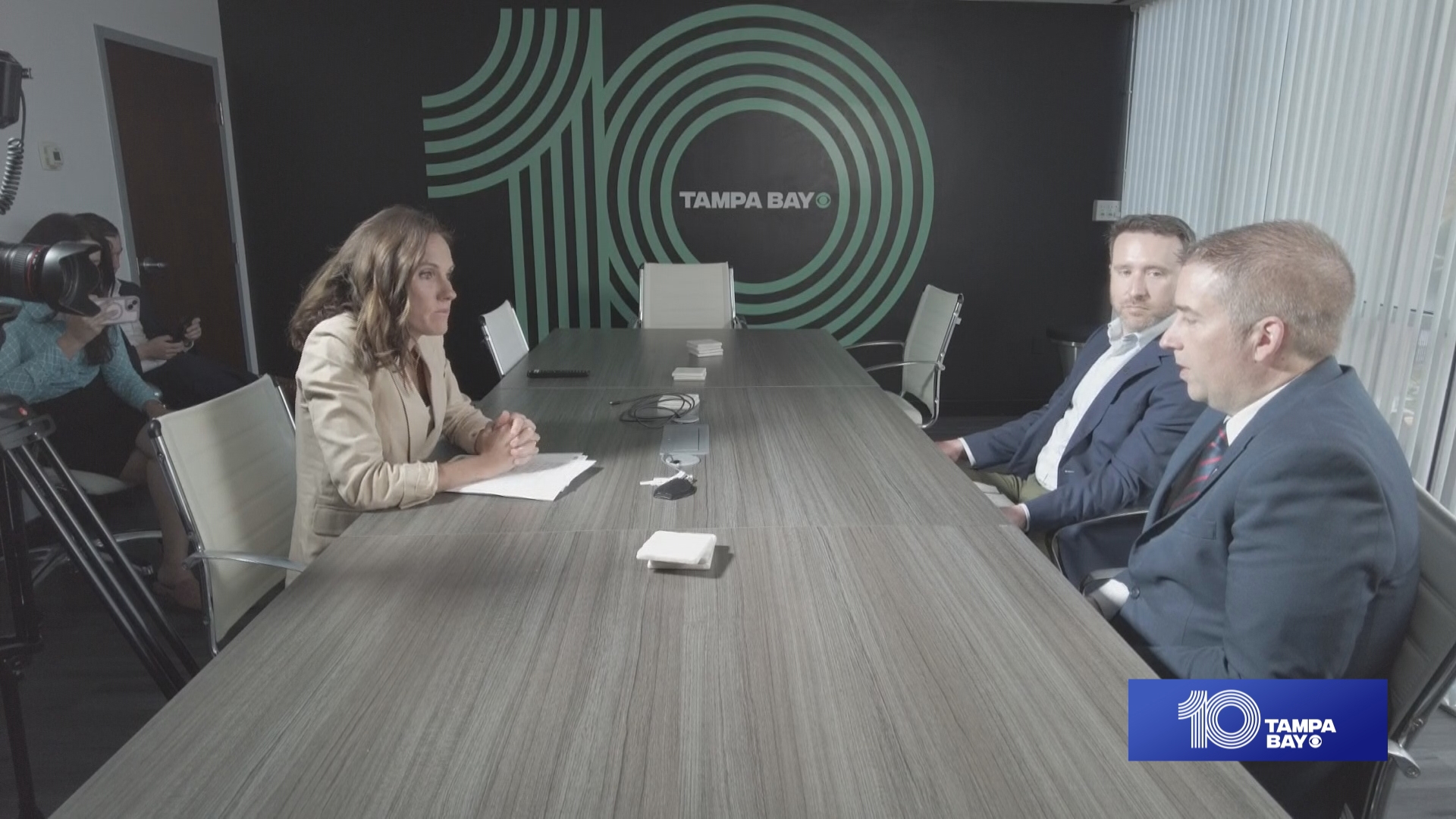Michael King calmly drove his dark green Chevy Camaro down U.S. 41 in North Port. In his back seat was a kicking, screaming Denise Amber Lee.
The 21-year-old mother of two young boys had just been abducted from her home. Trying not to get her kidnapper's attention, she quietly dialed 911 from her back seat.
"I just want to see my family," she can be heard pleading on the call. "Please let me go, I just want to see my family again."
Denise answered as many questions from the operator as possible, not trying to tip off her abductor.
She was able to get her full name out to the operator and each time she was asked if she knew where she was, Denise was then heard pleading to the man in the car, asking where they were going.
The operator was heard confirming her name, "Your name is Denise Lee?
Lee: "Ummhuh..."
Operator: "Can you tell what street you're on?"
Lee: "No."
Operator: "Do you know the guy who is with you?"
Lee: "No."
Even when the operator asks for the radio to be turned down, Lee did what she could... telling the man, "I can't hear, it's too loud."
Over and over though, she pleads to see her family and her kids again.
Nearly six minutes into the call, the radio is turned off and the dispatcher hears from Denise Lee for the last time, "Are you going to help me? Are you going to let me out now? Help, please."
The phone went silent.
It was January 17, 2008. Three hours after Denise Lee's husband reported her missing, North Port police were searching her neighborhood. Officers in Sarasota County were looking for a dark green Camaro that may have been involved.
Another call came in to 911 from Jane Kowalski, who was stopped next to a Camaro at a red light on the Sarasota-Charlotte County line.
Someone in the car next to her "kept banging on the window," she told the dispatcher. She went on to say the person was "screaming... like 'Get me out of here,' screaming."
Kowalski even followed the Camaro until it turned onto Toledo Blade Boulevard, and told dispatchers its location. She later told 10 News, "I knew something was wrong. You know when you have a gut instinct, make the call. Better to be safe than sorry."
But Kowalski's information never made it to Sarasota deputies out on the street. Because she was right at the county line, her 911 call went to a cell tower in neighboring Charlotte County, where dispatchers were unfamiliar with the urgent search for Denise just a few miles away.
Later that night, a state trooper spotted the Camaro on Toledo Blade Boulevard, and stopped Michael King. Police say he was soaking wet from the waist down and a wet shovel was in his car.
The next day searchers found Lee's body, buried in a swamp in southern Sarasota County. She was naked, had been sexually assaulted, and had been shot to death.
Michael King would later be convicted of Lee's murder, and is now on death row. But two 911 calls, one from the victim herself, leaves open the question of how effective cell phones can be in emergencies. Since Denise's kidnapping and murder in 2008, the state law has been changed to improve dispatch training... but cell phone location data is still not instantly pushed through to emergency centers.
"When you call 911, over 80 million calls every year are not located properly," Denise's widower, Nathan Lee, told 10 News in 2013.
Almost every app on your cell phone can track exactly where you are, which is why we launched a Gannett national investigation into a shockingly high number of emergency 911 calls across the country that cannot be traced.
Old fashioned land line telephones deliver the caller's address within three seconds. The FCC estimates more than 70 percent of all 911 calls now come from mobile devices. In more than half of all American homes, a cell phone is the only phone.
"We get location information from cell phones on just a little less than 50% of our calls," says Jerry Wheeler, Sarasota County's Public Safety Communications manager.
![Jerry Wheeler, Sarasota County Public Safety Communications [ID=23679435] [ID=23679435]](/Portals/_default/Skins/PrestoLegacy/CommonCss/images/pullquote.jpg) Wheeler says in a 911 center, different systems talk to each other for each call, while cell towers bounce signals that are not always accurate enough.
Wheeler says in a 911 center, different systems talk to each other for each call, while cell towers bounce signals that are not always accurate enough.
"If the signal is not strong enough, then all we get is the call from one tower, which simply just tells us which tower it's coming from, and doesn't give us information exactly on where that phone is in relation to the towers. The 911 call could be miles away," he explained.
The first failure is that the cell tower's address -- not the victim's location -- determines which 911 center answers the call. The second failure is the mapping system that doesn't extend beyond the call center's jurisdiction.
The third and most critical failure is that a shockingly high number of wireless 911 calls don't display the location of the cell phone.
"There are times when it doesn't come up at all," said Chief Carl Hall at Alpharetta, Georgia's 911 center. "Every day we receive calls where we get a tower address and that's it."
Gannett journalists across the country found the numbers vary widely, but in some states -- such as California, Colorado, Minnesota and yes, right here in Florida -- emergency responders could have trouble locating cell phones roughly half the time.
Counties in Tampa Bay have a wide range of figures for location data:
- Pinellas County has the best rating - 93%
- Hillsborough County - 57%
- Pasco County - 60%
- Sarasota County - 42%
- Manatee County tells us they do not keep track
Even at 93 percent, Pinellas officials say they are ready to update and improve even further, as needed. Pinellas County Emergency Services Director Chuck Freeman tells us, "There are no-holds-barred in technology. If there is something new out there, we get it."
Tom Mitchell, the CEO for GPS tracking company ActSoft, Inc. in Tampa, says the technology is available for 911 centers to use and cost isn't the issue... so what is?
"Privacy is a gigantic issue. Cell phone companies and their legal teams are scared of it," said Mitchell. He does say there are limitations to the technology, such as tracking a cell phone call from deep inside a building.
Cell phones have allowed us to reach 911 from anywhere, but rescuers can't reach us if they can't find us.
Back in December, Rear Admiral (ret.) David Simpson, the chief of the Federal Communications Commission's Public Safety and Homeland Security Bureau wrote, "We are not where we need to be on location accuracy for wireless 911 calls. This puts American lives at risk."
In the letter, the FCC acknowledged that "even a few minutes of delay can cost lives." Click here to read the letter (PDF)
Mobile phones not only know where they are, they tell us where to go. Apps can use that data from a phone's GPS, compass and barometer and upload it to the Internet.
But dispatchers don't receive any of this critical information when you dial 911.
Instead of mandating the creation of a 911 app, the commission approved new standards that also show just how bad the problem is.
Nineteen years ago, the FCC required wireless carriers to locate 95 percent of GPS-enabled phones in an emergency. Those rules still apply, but only to outdoor calls; more than half of cell phone 911 calls come from indoors.
The FCC updated those rules earlier this year, with the intent of improving the ability of first responders to "locate Americans calling for help from indoors, including challenging environments such as large multi-story buildings, where responders are often unable to determine the floor or even the building where the 911 call originated."
The FCC's new goal is to give the wireless carriers another two years to locate just 40 percent of all cell phones calling 911. In three years they'll have to find half. In five years: 70 percent.
"At six years, they must deliver dispatchable location or x and y coordinates within 50 meters of the caller for 80 percent of all wireless 911 calls," said FCC lawyer Dana Zelman.
So that means six years from now -- in the year 2021 -- cell phone carriers still won't be required to locate one out of every five calls.
The new rules also do not address the persistent issue of wireless calls reaching the wrong 911 center, as what happened when Jane Kowalski saw Denise Amber Lee screaming from inside that green Camaro in 2008. The updated standards still rely on the tower's address for deciding which call center gets the call.
The FCC had earlier proposed a 30-second limit to locate all wireless 911 calls -- not just for outdoors -- but the commission abandoned that idea, instead adopting new standards written largely by the big cell phone companies. One commissioner wrote it would be "unfair to saddle them with obligations that cannot be met."
Meanwhile, the problem throughout the state of Florida is that technology for 911 centers has not been implemented, despite the taxes and annual $215 million the state spends on 911.
Former Manatee County 911 Communication Director Ron Koper tells us, "It's about getting agencies together and mandating and agreeing to a platform that will work for the area ... in the state of Florida, we are not quite there yet."
Koper tells us that the funding for this technology improvement needs to be "if Florida wants everyone on the same page, they are going to have to mandate something."
The money goes toward improving technology, but there's another $2 billion in communication taxes that aren't dedicated to improving communications.
But for Denise Amber Lee's husband Nathan, he thinks the cost should not matter when it comes to life and death.
"I would pay 10 times that to bring my wife back."
Digitally produced by Chris Collette. Contributing: WXIA 11Alive Atlanta.


